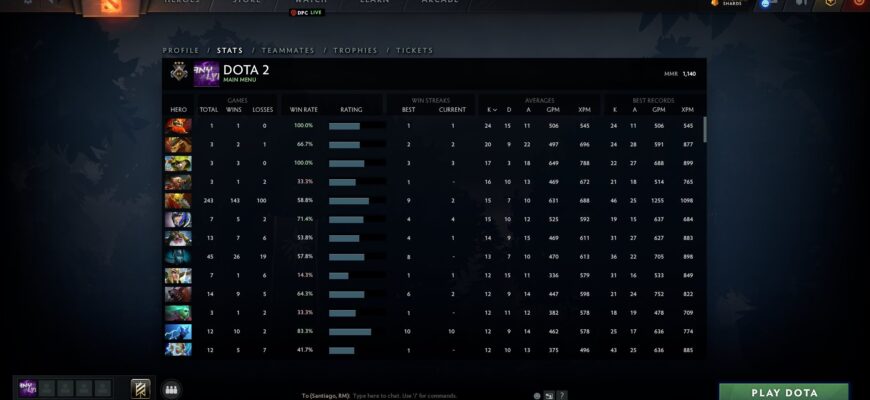Have you ever pondered why the numbers on the Dota 2 competitive ladder seem to be steadily climbing, almost relentlessly? While the pursuit of a higher Matchmaking Rating (MMR) is a fundamental motivation for countless players, an intriguing phenomenon, remarkably akin to economic inflation, appears to be at play within the game`s ranking system. A recent theory, articulated by the insightful analyst Maelstorm, casts a spotlight on this peculiar trend, suggesting it stems not merely from a global improvement in player skill, but from a foundational aspect of the game`s rating architecture itself.
The Curious Case of the Bottomless Pit
At the core of Maelstorm`s compelling theory lies a deceptively simple observation: the inability for a player`s MMR to plummet below a certain floor, typically set at 1 MMR. Picture a vast, dynamic pool of points. In an ideally balanced system, points would seamlessly transfer between participants – winners accrue, losers shed, and the grand total remains largely constant. New players entering the fray would introduce a fixed amount of points, perhaps offset by the departure of inactive accounts. However, Dota 2’s system exhibits a critical deviation at its lowest echelon.
Consider a scenario where multiple players find themselves at the absolute minimum MMR. If they emerge victorious from a match, they will, as per design, gain points (e.g., +20). Yet, if they suffer a defeat, they are incapable of losing points because they are already at the predefined minimum threshold (1 MMR). This seemingly minor detail creates a persistent, net injection of new points into the system with every such match played at the very bottom. Each game where losing players simply cannot lose what they don`t possess effectively `prints` new MMR currency. These freshly minted points then percolate upwards through the system, primarily benefiting players who maintain a consistent win rate above 50%, thereby allowing their individual MMR to ascend uncontrollably.
Double Down: The Accelerant to the Inflationary Fire
If the inherent design mechanism wasn`t sufficiently intriguing, the widely utilized “Double Down” tokens are reported to act as a significant accelerant to this ongoing inflationary process. These tokens grant players the option to double their MMR gains (or losses) for a single, high-stakes match. While intended to introduce a strategic gamble and heighten excitement, their impact at the lowest MMR tiers is particularly pronounced. At 1 MMR, a successful Double Down victory translates to a substantial gain of +40 points (or more, depending on the baseline), whereas a defeat still results in zero points deducted. For those at rock bottom, it`s akin to a risk-free lottery ticket, pouring an even larger volume of points into the economy with no corresponding mechanism for their removal.
In essence, the system functions much like a central bank operating with an unchecked printing press, continuously injecting currency without an effective, corresponding mechanism for withdrawal. The implication is clear: your 7,000 MMR today may, in a few years, hold the same relative value as 6,000 MMR once did. It`s not that you`re getting worse; the currency itself is simply devaluing.
Historical Context and Unchanged Dynamics
The fundamental architecture of Dota 2`s MMR system has remained remarkably consistent since its last significant overhaul in November 2017. That update introduced the now-familiar medal system and the concept of bi-annual seasonal recalibration. While these additions certainly provided temporary shifts and a refreshed visual representation of progress, they did not fundamentally alter the underlying point distribution mechanism that Maelstorm so astutely identifies. The persistent nature of this inflation strongly suggests it is an inherent consequence of the system`s design rather than a sporadic anomaly or unintended bug.
The Echo from the Pros: No[o]ne`s Call for a Hard Reset
The concept of MMR inflation isn`t confined solely to theoretical discussions among analysts. Professional players, who inhabit the very pinnacle of the competitive ladder, have also articulated their concerns. Vladimir “No[o]ne” Minenko, a widely respected carry player, has reportedly echoed Maelstorm`s observations, advocating for a more drastic solution: periodic, global MMR resets. Such resets, a common feature in many other competitive gaming titles, would effectively “deflate” the system, re-centering the overall MMR distribution and potentially restoring a clearer sense of achievement to reaching specific numerical benchmarks, which can feel increasingly arbitrary as the overall pool inflates.
Implications for the Competitive Landscape
So, what does this ongoing inflationary trend mean for the vast majority of Dota 2 players? The implications are subtle but significant:
- Shifting Benchmarks: What was once considered a highly prestigious MMR threshold might, over time, become more commonplace. The “average” MMR steadily creeps upwards, raising the bar for what constitutes “high” MMR.
- Illusion of Progress: While your numerical MMR might be higher than it was a year ago, the actual relative skill gap between you and other players might not have changed as much as the numbers suggest. It`s a bit like seeing your bank balance increase during hyperinflation; the numbers are bigger, but purchasing power remains stagnant or declines.
- Competitive Integrity: For the highest echelons of play, if MMR thresholds continue to inflate without corresponding true skill progression, it could subtly warp perceptions of top-tier achievement and create a ladder where raw numbers overshadow genuine skill differentiation.
The Way Forward: A Design Question for Valve
The intriguing theory of Dota 2`s MMR inflation presents Valve with a compelling design challenge. Is the current system truly functioning as intended, or is it time for a more fundamental rethinking of its economic principles? Implementing additional mechanisms, such as decaying MMR for inactive players (to remove points from circulation), or more rigorous seasonal resets that genuinely redistribute the player base, could offer viable solutions. As players worldwide continue their tireless climb up the ladder, the “invisible hand” of MMR inflation will undoubtedly remain a fascinating topic of discussion and debate within the vibrant Dota 2 community – a curious economic subplot in the grand strategy of the Ancients.







